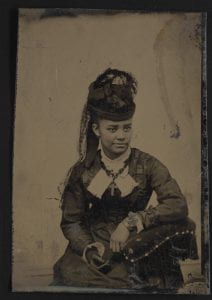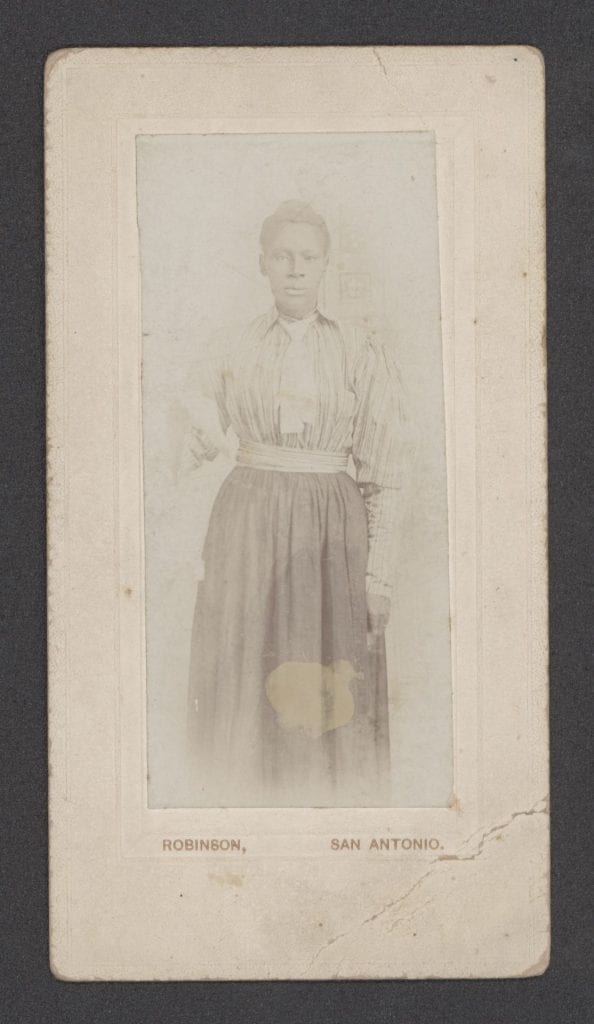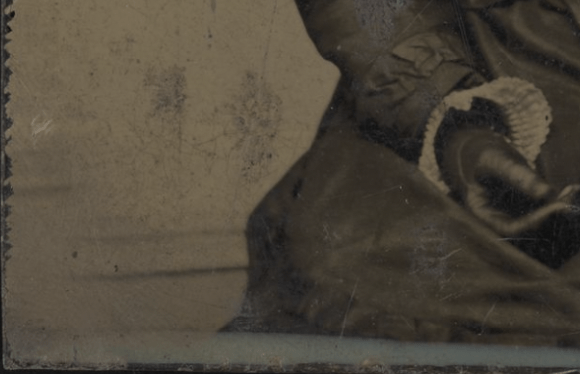In taking care to unpack the materiality of a given photograph, who do we leave behind? Is it possible to acknowledge all the hands involved in the process?
“The photographer’s thumbprint, a common artifact, is in the lower right corner.”1
The above quote is culled from a description of a tintype with an unidentified sitter and an unidentified photographer. The tintype was made between 1860 and 1880. The description is by colleagues who previously contributed to the Black Portrait Photograph Collection. I rely on their words and ways of seeing to garner a new perspective as I approach a cabinet card of an unidentified sitter and an unidentified photographer. The portrait was taken at the end of the nineteenth century or perhaps the early twentieth century at Robinson studio in San Antonio, Texas. Like the tintype of the woman from some thirty years earlier, the cabinet card of the woman bears a “common artifact,” too. The artifact in question, in both instances, are fingerprints.

Unidentified Photographer, Portrait of a seated woman, Tintype, Special Collections, University of Delaware Library, Museum and Press.
My colleagues’ use of “artifact” is brilliant. In one sense, it might be taken to mean “a defect in an image (such as a digital photograph) that appears as a result of the technology and methods used to create and process the image.”2 In another sense, it might also mean a “simple object (such as a tool or ornament) showing human workmanship or modification as distinguished from a natural object.”3 Or even “an object remaining from a particular period.”4 Fingerprints left by the photographer or the people tasked with post-production processes are common. The traces they quite literally left behind adorn the surfaces of tintypes, albumen prints, silver-gelatin prints, and the like. Their labor is materialized. Their fingerprints are a remain of the labor invested in image-making.

What is so brilliant about the use of “artifact,” in all the senses listed above, is that it gets at the crux of the materiality of early photographs and their various formats, both as physical objects that exist in a physical sense and the “digital surrogates” that adorn this page and the other spaces they have been uploaded. As a “defect,” a blemish, fingerprints remind us of the unidentified people who are waiting to be acknowledged. All the hands involved in the production, post-production, and afterlife of photographs like this tintype, like this cabinet card. The fingerprint as an artifact also speaks to the layered materiality of photographic objects. As composite objects, photographs contain pluralities of narratives.


The fingerprint on the unidentified woman’s skirt reminds us of the significance of all the processes embedded within ways of knowing, knowledge making, and, more poignantly, how crucial it is to remember. The fingerprint on the corner of the tintype calls on us, too.
In between the liminal spaces of WordPress, ArtStor, or the reading room, we try to remember.
Citations
1. “Portrait of a seated woman,” https://library.artstor.org/#/asset/29695974;prevRouteTS=1701742777419
2. “Artifact,” Merriam-Webster, December 4, 2023, https://www.merriam-webster.com/dictionary/artifact
3. Ibid.
4. Ibid.

